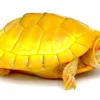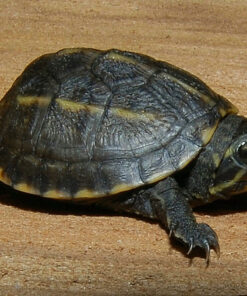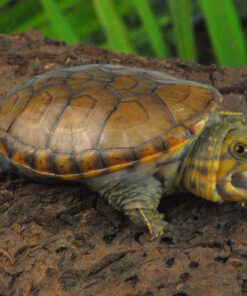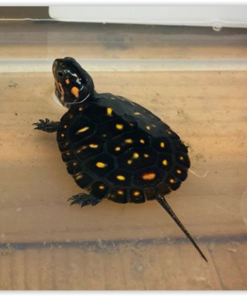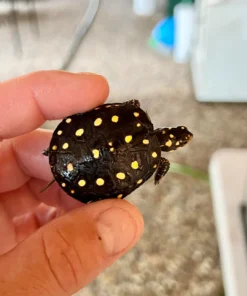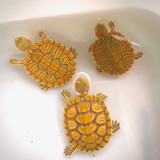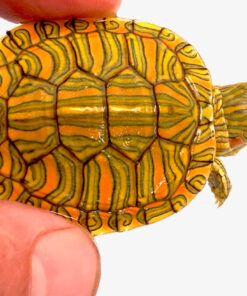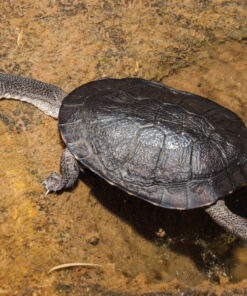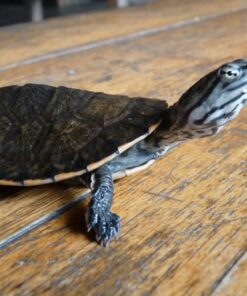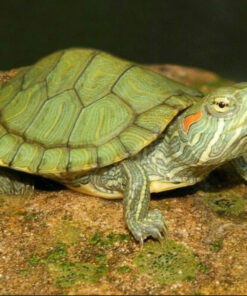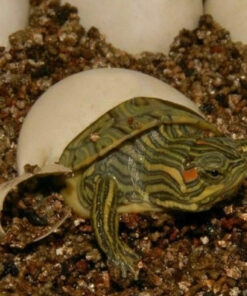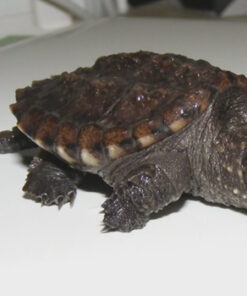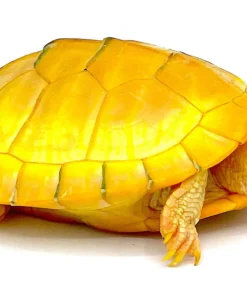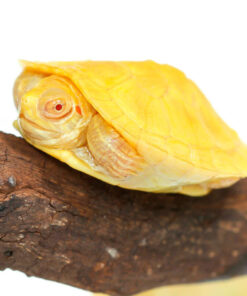$224.99
Buy captive-bred Baby Ceram Asian Box Turtles (Cuora amboinensis amboinensis) – 1.5-3 inches in shell length. Easy to care for, personable pets for the whole family.
Category: TURTLES FOR SALE
Asian Box Turtles For Sale: A Fascinating Species for Enthusiasts
Asian Box Turtles are a highly sought-after species among reptile collectors and enthusiasts due to their captivating appearance and fascinating behaviors. Known for their adaptability, resilience, and distinctive markings, they are one of the most popular turtles available for sale today. Whether you are a seasoned reptile hobbyist or a first-time turtle owner, Asian Box Turtles are an excellent addition to any collection.
In this comprehensive guide, we’ll explore everything you need to know about these remarkable creatures, including their care requirements, natural habitat, and where to **buy Ceram Asian Box Turtle for sale** as well as other varieties. Additionally, we’ll compare them with species like the **desert ornate box turtle**, offering insights to help you make the best choice when searching for an exotic turtle.
Introduction to Asian Box Turtles
The **Asian Box Turtle** is part of the *Cuora* genus, which includes several subspecies known for their ability to completely close their shells, hence the term “box” turtle. These turtles are primarily found across Southeast Asia, including regions like Thailand, Malaysia, and Indonesia. Their adaptable nature allows them to thrive in both aquatic and terrestrial environments, making them unique among turtles. Asian Box Turtles are typically medium-sized, with hard shells, and their distinctive colorations and markings make them visually striking.
Types of Asian Box Turtles
There are multiple species within the *Cuora* genus, and each has its own unique characteristics. However, one of the most coveted subspecies is the **Ceram Asian Box Turtle** (*Cuora amboinensis ceramensis*), which is known for its vibrant colors and appealing patterns.
The Ceram Asian Box Turtle
The **Ceram Asian Box Turtle**, also known as the Amboina Box Turtle, hails from Indonesia’s Maluku Islands, particularly Ceram. This subspecies is known for its relatively compact size, striking yellow markings on its head, and smooth, high-domed shell. If you are looking to **buy Ceram Asian Box Turtle for sale**, it’s important to be aware of its particular care requirements, as it needs both aquatic and terrestrial elements to thrive.
Natural Habitat and Behavior of Asian Box Turtles
In the wild, Asian Box Turtles are commonly found in tropical rainforests, wetlands, and swamps. They are semi-aquatic, spending time in both water and on land. Due to their varied habitat, they have developed a unique ability to adapt to diverse environments, allowing them to survive in various conditions. Whether wading through shallow streams or foraging for food on land, these turtles are incredibly versatile.
Asian Box Turtles are omnivores, feeding on a mixture of plant material, insects, and small aquatic animals. In captivity, it’s crucial to replicate this balanced diet to ensure the turtle’s health and longevity.
Daily Activities
In terms of behavior, Asian Box Turtles are primarily diurnal, meaning they are active during the day. They spend a significant portion of their time basking under the sun, foraging for food, and exploring their surroundings. Despite their adaptability, they prefer humid environments, and adequate moisture levels are critical to their well-being. In the evening, they often retreat to a cool, shaded area or burrow into moist soil to rest.
Housing and Care for Asian Box Turtles
Setting up the ideal habitat for an Asian Box Turtle requires careful consideration of their semi-aquatic nature and natural environmental preferences. They are relatively easy to care for, but providing the right enclosure and meeting their specific needs is essential for keeping them healthy and content.
### 1. **Enclosure Size and Setup**
Since Asian Box Turtles are active and require both land and water, their enclosure needs to be spacious. For a single turtle, a 40- to 50-gallon tank is suitable, but larger is always better, especially if you plan to keep multiple turtles. The enclosure should be divided into a land area and a shallow water section.
#### Land Area
The land portion of the enclosure should have plenty of space for the turtle to roam, dig, and hide. You can use a substrate like coconut fiber, soil, or a combination of both, which allows for natural burrowing. Additionally, provide hiding spots using logs, rocks, and plants to create a sense of security for the turtle.
Water Area
The water section should be shallow enough for the turtle to comfortably walk and wade through, as they are not strong swimmers like fully aquatic species. A depth of about 2-4 inches is typically sufficient. The water should be clean and fresh, so it’s essential to use a filtration system to maintain cleanliness.
### 2. **Temperature and Humidity**
Asian Box Turtles thrive in warm, humid environments. The ambient temperature of the enclosure should be kept between 75°F and 85°F, with a basking spot that reaches up to 90°F. Use a heat lamp or ceramic heat emitter to maintain these temperatures.
Humidity levels should be kept high, around 70-80%, to mimic their natural tropical habitats. Regular misting or the use of a humidity system can help achieve these levels. Humidity is especially important for the health of their respiratory system and skin.
### 3. **Lighting**
Turtles need access to UVB lighting to synthesize vitamin D3, which is essential for calcium absorption and shell health. A UVB bulb should be placed above the enclosure and kept on for 10-12 hours per day to simulate natural sunlight. This is particularly important if your turtle doesn’t have access to natural outdoor sunlight.
### 4. **Diet and Feeding**
Asian Box Turtles are omnivores, meaning their diet should include a combination of animal protein and plant matter. In captivity, it’s important to provide a varied diet to ensure they receive all the necessary nutrients.
Protein Sources
– **Insects**: Crickets, mealworms, and waxworms are excellent sources of protein for your turtle.
– **Fish**: Small feeder fish like guppies or goldfish can be offered occasionally.
– **Snails and Worms**: These are great natural protein sources that mimic the turtle’s diet in the wild.
Plant Matter
– **Leafy Greens**: Kale, collard greens, and dandelion greens should make up a significant portion of their diet.
– **Fruits**: Offer fruits like strawberries, bananas, and melons in moderation as a treat.
Commercial Turtle Pellets
High-quality commercial turtle pellets can be a convenient and nutritious addition to their diet, but these should not be the sole source of food.
### 5. **Handling and Temperament**
Asian Box Turtles are generally docile and shy creatures. While they can become accustomed to human interaction over time, they are best observed rather than handled frequently, as handling can stress them out. Their calm nature makes them ideal pets for those who enjoy observing natural reptilian behaviors in a semi-wild setting.
## Common Health Issues and Care Tips
Asian Box Turtles are hardy, but they can be prone to certain health issues if not cared for properly. Here are some of the most common issues and how to prevent them:
### 1. **Respiratory Infections**
Respiratory infections are common in turtles that are kept in environments with insufficient humidity or incorrect temperatures. Signs of a respiratory infection include wheezing, mucus discharge from the nose, and lethargy. Maintaining proper humidity and temperatures can prevent this.
### 2. **Shell Rot**
Shell rot is a bacterial infection that can occur if the turtle’s environment is too damp or unclean. Regular cleaning of the enclosure and providing a dry basking area can prevent this.
### 3. **Metabolic Bone Disease**
Without proper UVB lighting and calcium supplementation, turtles can develop metabolic bone disease, which weakens their bones and shell. Ensure your turtle receives adequate exposure to UVB light and feed them calcium-rich foods.
Comparing Asian Box Turtles and Desert Ornate Box Turtles
When searching for box turtles, you might come across the **desert ornate box turtle**, which is native to North America. While both species are box turtles, they have distinct differences in habitat preferences, size, and care requirements.
– **Habitat**: Desert Ornate Box Turtles thrive in arid, dry environments, while Asian Box Turtles prefer tropical, humid habitats.
– **Size**: Desert Ornate Box Turtles are typically smaller than Asian Box Turtles, reaching about 4-6 inches in length, whereas Asian Box Turtles can grow up to 8-10 inches.
– **Diet**: Both species are omnivores, but the desert ornate box turtle has a higher preference for insects and vegetation suited to its desert habitat.
If you’re looking for a turtle that is more aquatic and thrives in humid environments, the **Asian Box Turtle** or the **Ceram Asian Box Turtle** is a great choice. However, if you’re interested in a species that requires a drier environment, the **desert ornate box turtle** might be more suitable.
Buying Ceram Asian Box Turtles and Other Varieties Online
When looking to **buy Ceram Asian Box Turtle for sale**, or any other type of box turtle, it’s essential to choose a reputable breeder or seller. At NewYorkReptiles.com we ensure that our turtles are healthy, well-cared for, and ready for their new homes. Purchasing from a trusted source guarantees that you receive a healthy, captive-bred turtle with the proper care instructions.
Conclusion
Asian Box Turtles are a remarkable species that make for a unique and engaging pet. Their semi-aquatic nature, beautiful markings, and easy-going temperament make them perfect for reptile enthusiasts of all levels. Whether you’re looking for a **Ceram Asian Box Turtle** or want to compare them with the **desert ornate box turtle**, understanding their care requirements and natural
Related products
TURTLES FOR SALE
$199.99
Sale!
TURTLES FOR SALE
Sale!
TURTLES FOR SALE
TURTLES FOR SALE
$299.99
TURTLES FOR SALE
Red Ear Slider Turtle for sale | #1 Best Exotic Pets for Sale
$1,199.99
TURTLES FOR SALE
$149.99
TURTLES FOR SALE
$249.99


